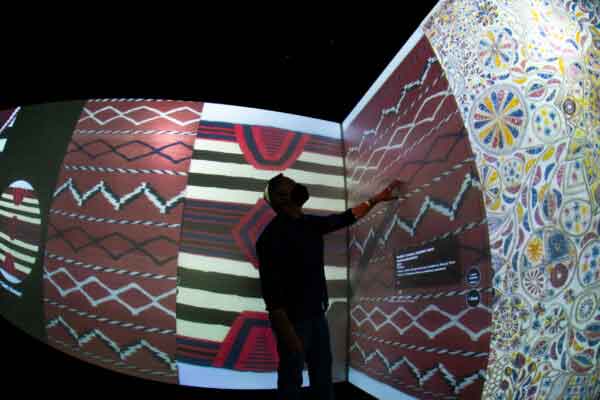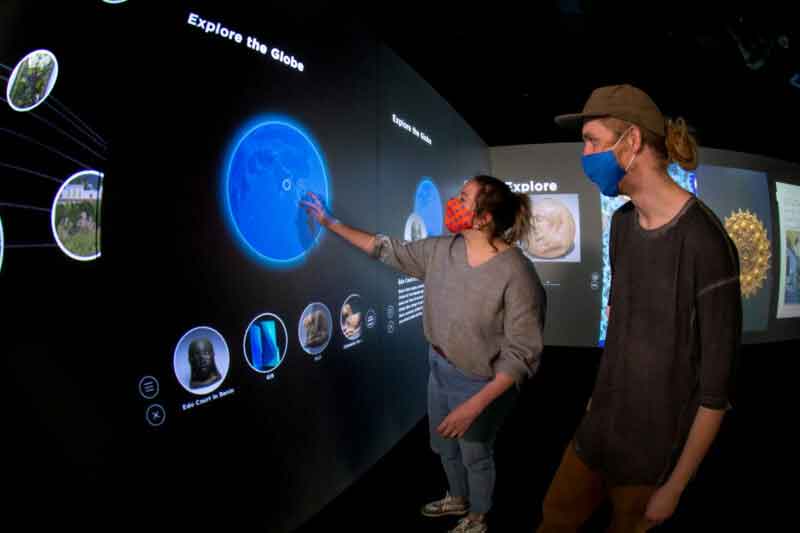Solution Summary
- 90 ft (27.4 m) of continuous images
- Interactive touch glass screens
- 8 high brightness projectors
- Stereoscopic 3D/VR capable
- 7.1 spatial and directional sound
- Gesture recognition cameras
- Voice recognition; assistive listening
- Networked, graphics computing
- Sophisticated user interface
A New Light on the Arts and Culture
In an era when every TV boasts an “immersive” display and even your portable Bluetooth speaker claims to offer an “an immersive audio experience,” you might not take notice of a new arts space that makes a similar promise. But in the case of the Stein Luminary at Boise State University, “immersive” isn’t hyperbole. It’s an understatement.
As unique as this facility is, the genesis of the project was nothing new for Mechdyne. A client approached us with a simple question: “Can you bring our idea to life?”
Lisa Hunt, Ph.D., interim director of the Luminary, was the guide for completion of the original vision for an immersive arts space that could deliver cutting-edge content focused on visual and performing arts and cultural exhibitions; a space that invited interaction between visitors and artists; that used technology to “illuminate perspective, transform perspective and spark imagination.”

They had us at immersive.
Digital and Dimensionalized
An all-digital environment, the Stein Luminary invites interaction with 90 feet of wrap-around, touch-activated glass walls that display a range of interactive and sensory experiences. Beyond simply viewing a world of arts, cultures and sciences, visitors can zoom into high-resolution landscapes, paintings, and panoramas – entering the visuals through this interactive and virtual media portal. Beyond imagining oneself in a new environment, says Hunt, “You take a trip through the looking glass, discover yourself in new places, and visualize the possibilities.”
The challenge for Mechdyne: How to enable an experience so powerful and seamless that visitors feel utterly transported.
Working in close collaboration with Dr. Hunt, Dr. Steve Cutchin, and their team, Mechdyne built an environment with eight ultra-high-brightness and 3D/virtual reality capable projectors, gesture and voice recognition capabilities; directional audio and 7.1 surround sound; a customized user interface for system control; assistive listening capabilities; and a sophisticated remote technical support system. Powering it all: The Luminary and their content design partner, Downstream, took more than two years to develop a sophisticated image repository and user experience interface driven by a suite of high-powered graphics computers
“The images have to be utterly seamless to remove any potential for distraction. A real key to success is maintaining image linearity and brightness across the 90 feet of screen. We don’t want anything to negatively affect the visual experience,” says Chad Kickbush, General Manager of Mechdyne’s Audio Visual and Virtual Reality Business Unit.
To ensure Mechdyne delivered on the Luminary’s promise, every element of the experience was staged in advance at the Mechdyne tech center. Painstaking work ensured smooth touch capability, spatial and directional audio, control programming, and complete continuity of experience for users simultaneously engaging with the system.
The Luminary has been opening its doors to other project stakeholders and some school classes before fully opening to the public. Yet even with limited exposure, the facility has ignited interest from a variety of College departments and external organizations, already proving itself ideal for diverse applications.
In addition to, say, enabling visitors to see each of Vermeer’s 34 paintings simultaneously, the Luminary provides educators the opportunity to present data and explain scientific processes in entirely new ways. It enables musicians to create dimensional performances unlike anything their audiences have experienced. School children can use the space to co-create and discuss art. The flexibility and multi-sensory nature of the technology also enables a more immersive experience for the visually and hearing impaired. “My biggest surprise with this system,” says Hunt, “is the touch interaction. Young people are native to this technology. They have no fear, dive in, and look around. Users share the same image, but look at it from different perspectives and talk about it. Complete strangers have worked together. Everyone is participating.” This absolutely achieves the Luminary’s goal of encouraging conversation about art and digital media.

Individual engagement. Shared experience.
The Luminary was designed to engage visitors both individually and collectively, and the public’s initial reactions suggest Hunt hit her mark. “We bring in thousands of art works via collections that have been made available through museums worldwide [and allow] everyone to explore all the artwork side by side with each other, to pan in and zoom around to get all the details,” explains the interim director. “When you come into the Luminary, you’re going to be able to try some unexpected ways of looking at art. I think it’s going to illuminate your perspective [and] truly transform the way you think and look at art. And it’s also going to make you feel very creative.”
The eventual next step for the Luminary is enabling students and others to create original content for display. Since the Luminary is located at Boise State, content could come from many disciplines. There have been discussions with the geography department for LIDAR (3D scanning using Light Detection and Ranging) and 360 landscape panoramas, and the music department for visual performances. The gaming and media department has already coded a ‘music response visualizer’ that automatically creates kaleidoscopic visuals based on music performed in the space. The Luminary is developing a screen template that content creators across disciplines can use to easily format for the immersive screens.
Echoes Chad Kickbush of Mechdyne, “This is an environment that’s limited only by imagination. What we’ve built, in effect, is an expansive, digital canvas that can accommodate a vast range of individual and shared experiences.”
This is unlike most art experiences where the objects are behind glass or ropes. Even better, all art in digital format is accessible, whereas many physical art objects are kept in storage because there isn’t room to display it all. At the Luminary, says Hunt, the only directive for visitors is, “Please touch the art.”
All Images Credited to: Priscilla Grover, Boise State University, Office of Communications and Marketing.


